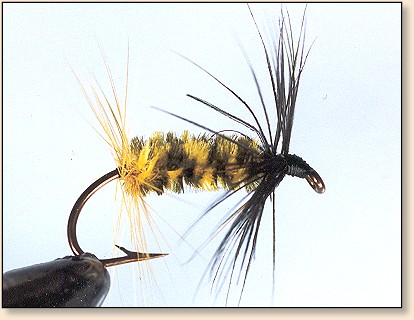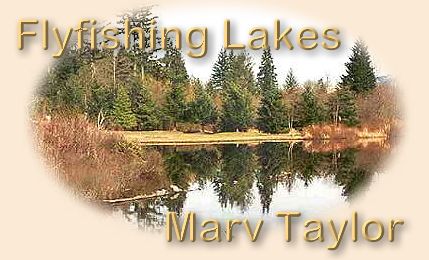|
Some fly patterns just look productive. You know the
minute you tie one on, you're going to interest the
fish. But as much as I like fore and afts, they just
don't really look all that fishy. I'm pretty sure I
have not yet found aquatic insects with hackle-like
appendages on both ends of their bodies; Unless it has
been a simi-bald caterpillar. Not only that...but these
fore and aft patterns often have different colored hackle
on each end.
I first became aware of this type of trout fly at Henry's
Lake in 1972 (I had only been tying for 4 or 5 years,
and had only a couple of very poor pattern books in
which to do research). Vina and I were camped next
to an Air Force family from Cheyenne, Wyoming. Besides
being a pilot, Colonel Bill Moberly was also a commercial
fly tyer. His number one selling pattern, was a fly he
called his Peacock Nymph. We fished together for a
week, both at Henry's Lake and at Island Park Reservoir,
using his peacock fore and afts about half the time.
We caught a bunch of fish with the fly. One evening
I took a 7-pound rainbow/cutthroat hybrid with Bill's
fly at the Big H, my largest trout at the lake at that
point in time.
The Moberly peacock is a simple pattern. Bill dressed
the fly on 6 through 10, 4X long hooks. It has a thin
peacock herl body, with three wraps of brown hackle at
each end (I can't prove it, but I think the very popular
Henry's Lake Renegade - featured in an earlier column- was
an off-shoot of this pattern).
I had just initiated a "Fly of the Week" feature in the Boise,
Idaho Statesman, so I ran the peacock fore and aft when
I returned home. A couple of weeks later, the Managing
Editor of the newspaper ran a photograph of some really
large rainbows he had taken from a 'no-name' lake in the
area. His fishing partner for the day had been Idaho's
new Governor (Cecil Andrus). Dick told me they had caught
all of their fish on the peacock fore and aft I had
featured in the Statesman.
About hat same time I got acquainted with a float tuber
at central Idaho's Horsethief Reservoir. One of his most
productive flies was a chenille bodied fore and aft, tied
on a 1XL hook. My new friend used a medium-olive chenille
for a body, a black hackle on the front, and a light olive
hackle on rear (see photo). I used fore and afts for a
few years, then drifted off to other patterns. Then in
the early 90s, I began experimenting with the pattern
again, using mostly the variegated chenilles I had become
so fond of, and my fore and afts began to produce again.
From about 1988 to 1993, central Idaho's Little Payette
Lake became one of our better western Idaho trophy trout
fisheries. Stocked with both Kamloops and Penask
rainbow trout (from Canada), anglers began landing
fish up to 5 or 6 pounds. I began playing around
with a fore and aft using a black and orange variegated
chenille. I had successfully used this chenille on
crawdad patterns when I was trying to fool Idaho's
Snake River smallmouth.
I added gold dyed grizzly hackle to both ends, a black
marabou tail, and weighted it with about a dozen wraps
of .015" fuse wire. It really didn't look all that
great, but couple it with a deep sinking line, and
the Little Payette Lake trout just wouldn't leave
it alone.
I haven't gone so far as to identify it as one of my
crawdad patterns yet, but I think maybe I should.
Just worry it along the bottom like a scurrying
crawdad, and hang on. The trout in my part of
the country have become pretty fond of it.

MARV'S FORE AND AFT
Hook: Mustad 9672, 3XL (or equivalent), sizes
6 - 10 weighted. While Bill Moberly tied his on 4XL
hooks, I prefer 3XL.
Thread: Black 6/0, prewaxed.
Tail: Black Marabou.
Rear Hackle: Gold dyed grizzly, 3 wraps.
Body: Medium sized black/orange chenille.
Front Hackle: Gold dyed grizzly, 3 wraps.
Head: Black 6/0, prewaxed.
TYING TIPS:
There are two types of "Halloween" chenille. The original
Halloween Leech uses a chenille called "black and burnt orange."
Marv's Halloween uses "black and orange." The latter is
a softer orange, actually more of a natural orange.
Burnt orange is a much deeper color. I've used both
of these variegated chenilles on this pattern and
find the softer orange to be much more effective.
FISHING TIPS:
I've always fished this fly down near the bottom. I
guess I consider any pattern consisting of black and
orange, a crawdad fly.
The tippet size is almost always determined by the
size of the fly. I tend, however, to go one size
heavier than normal on larger flies, particularly on
patterns like the crawdad that elicit pretty savage takes.
The knot I use to tie crawdad patterns on? This
decision is also influenced by the size of the fish.
My preference for larger flies, especially when
fishing over larger fish, is a through-the-eye-twice
clinch knot. If the fish are not taking well, I
will go back to the Duncan Loop. Although not quite
as strong as the TTET, the Duncan does offer the fish
a more natural drift.

OLIVE FORE AND AFT
Hook: Mustad 3906B, 1XL (or equivalent), sizes 6 - 12.
Thread: Black 6/.0, prewaxed.
Rear Hackle: Ginger saddle hackle, 2 wraps.
Body: Medium sized dark-olive/gold chenille.
Front Hackle: Black saddle hackle, 2 wraps.
Head: Black 6/0, prewaxed.
TYING TIPS:
I tied this pattern two ways: I tie it on heavy
wire hooks (Mustad 3905B), weighted. On other
versions, I use dry fly hooks (Mustad 94840),
hoping to keep the fly in the surface film.
FISHING TIPS:
Although I do fish this pattern on the bottom, as
with Marv's Fore and Aft, I also fish it in the film,
more as a drifting snail. ~ Marv
About Marv
You can reach Marv by email at
marvtroutman@juno.com or by phone: 208-322-5760.
|




